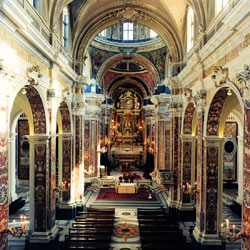
 Per Via Cattedrale si sbocca in un suggestivo scenario barocco sul quale si affaccia la Cattedrale dedicata alla Madonna della Madia, protettrice di Monopoli, la cui icona approdò miracolosamente nel porto, all’alba del 16 dicembre 1117.
Per Via Cattedrale si sbocca in un suggestivo scenario barocco sul quale si affaccia la Cattedrale dedicata alla Madonna della Madia, protettrice di Monopoli, la cui icona approdò miracolosamente nel porto, all’alba del 16 dicembre 1117.
L’evento viene ricordato ogni anno con una sentita rievocazione che vede la partecipazione dell’intera città nella stessa data e riproposto in forma solenne il 15 agosto, con luminarie e fuochi d’artificio.
L’originaria costruzione, edificata nel 1107 su una precedente chiesa preromanica, fu terminata dieci anni dopo impiegando le travi della zattera – ancora oggi conservate – che recarono in città la preziosa icona.
Completamente ricostruita nel corso del Settecento, la Cattedrale, caratterizzata dalla monumentale facciata e dallo svettante campanile, si presenta oggi come una delle più belle chiese barocche della Puglia.
Recentemente restaurata, presenta all’interno una luminosità sorprendente, una ricca decorazione in marmi policromi e alcune pregevoli tele di Giovanni Bernardo Lama e Stefano Buono (XVI sec.), di Palma il Giovane (XVII sec.) e di Francesco De Mura (XVIII sec.), sculture di Giuseppe Sammartino.
 Via Cattedrale leads to the charming Baroque setting in which the Cathedral dedicated to Madonna della Madia, the Saint protector of Monopoli stands out. The icon of Madonna della Madia landed to the seaport miraculously at the sunrise of December the 16th in 117. The poignant event of landing is commemorated every year in the same day with a huge community involvement. The Feast Day is commemorated with solemn celebrations on August the 15th with illuminations and fireworks. The original building built up in 1107 above a previous Romanesque church was completed ten years later with wooden timbers - still preserved- of the raft that carried on the precious icon of the town. During the XVIIIth century, the Cathedral was completely rebuilt, characterized by its monumental façade and its outstanding bell tower. So, today, it is one of the most beautiful churches in Apulia region. After many renovation works, on the inside, it has an outstanding brightness, decorated with rich polychrome marbles and with many fine paintings by Giovanni Bernardo Lama and Stefano Buono (XVIst century), Palma il Giovane (XVII cent), Francesco de Mura (XVIII cent) and the sculptures by Giuseppe Sammartino.
Via Cattedrale leads to the charming Baroque setting in which the Cathedral dedicated to Madonna della Madia, the Saint protector of Monopoli stands out. The icon of Madonna della Madia landed to the seaport miraculously at the sunrise of December the 16th in 117. The poignant event of landing is commemorated every year in the same day with a huge community involvement. The Feast Day is commemorated with solemn celebrations on August the 15th with illuminations and fireworks. The original building built up in 1107 above a previous Romanesque church was completed ten years later with wooden timbers - still preserved- of the raft that carried on the precious icon of the town. During the XVIIIth century, the Cathedral was completely rebuilt, characterized by its monumental façade and its outstanding bell tower. So, today, it is one of the most beautiful churches in Apulia region. After many renovation works, on the inside, it has an outstanding brightness, decorated with rich polychrome marbles and with many fine paintings by Giovanni Bernardo Lama and Stefano Buono (XVIst century), Palma il Giovane (XVII cent), Francesco de Mura (XVIII cent) and the sculptures by Giuseppe Sammartino.
Text translated within Progetto Bibliopolis Servizio Civile 2011